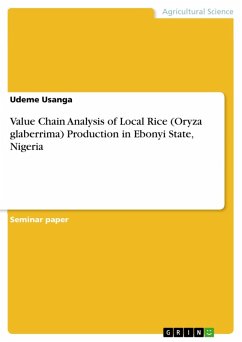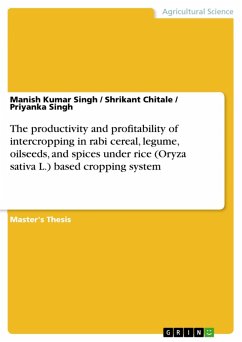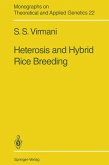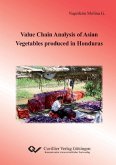Seminar paper from the year 2019 in the subject Agrarian Studies, grade: Conference Research Paper, National Open University of Nigeria (National Root Crops Research Institute, Umudike), course: Agricultural Production Economics, language: English, abstract: This study examined local rice production and value addition in Ebonyi State, Nigeria. Data were purposely collected from Ishiagu and Abakiliki from 144 rice value chain actors. It was found that wholesalers enjoy the largest share of the marketing margin, where at cross boundary markets, the wholesalers' profit goes as higher as N76.0/kg as compared to N39.5/kg, received by local farmers, showing unequal distribution of benefits among the local rice value chain actors, where reward to traders is extremely higher than that of producers. The profitability analysis shows a net return of N4, 085 with a BCR of 1.14:1, meaning that local rice production is viable and profitable in the area. Two separate multiple regression analysis, using the double-log regression as the lead equation for the producers (farmers) gave R2 of 0.923 and F-Ratio of 51.031, being an indication that 92.3% of the variation in the rice output was explained by the explanatory variables, while 7.70% was accounted-for due to error term (ei) and uncaptured variables. For the secondary value chain actors (transporters, millers, wholesalers and retailers), the exponential function gave R2 of 0.782 and F-Ratio of 38.104, being an indication that 78.2% of the variation in the rice output was explained by the explanatory variables (socio-economic characteristics) while 21.8% was accounted-for due to stochastic error term (ei) and uncaptured variables. The study recommended improvement of effectiveness in cooperative membership to attract finance for rice production, inputs and value addition, purchase of machines for processing and packaging, transportation and marketing. Furthermore, lack of adequate agricultural infrastructure and market information systems was observed to be critical areas of policy concerns. Policies for microcredit institutions on provision of credits to local rice farmers are also recommended to improve rice productivity by capacitating smallholder farmers to use modern agricultural machinery.
Dieser Download kann aus rechtlichen Gründen nur mit Rechnungsadresse in A, B, BG, CY, CZ, D, DK, EW, E, FIN, F, GR, HR, H, IRL, I, LT, L, LR, M, NL, PL, P, R, S, SLO, SK ausgeliefert werden.









